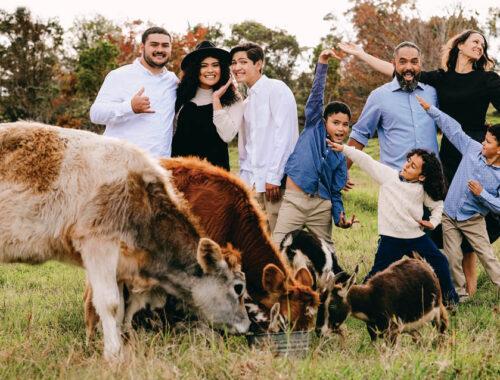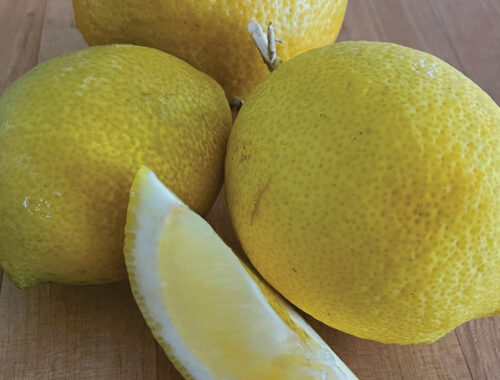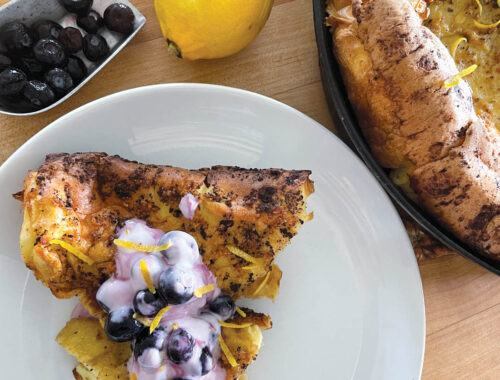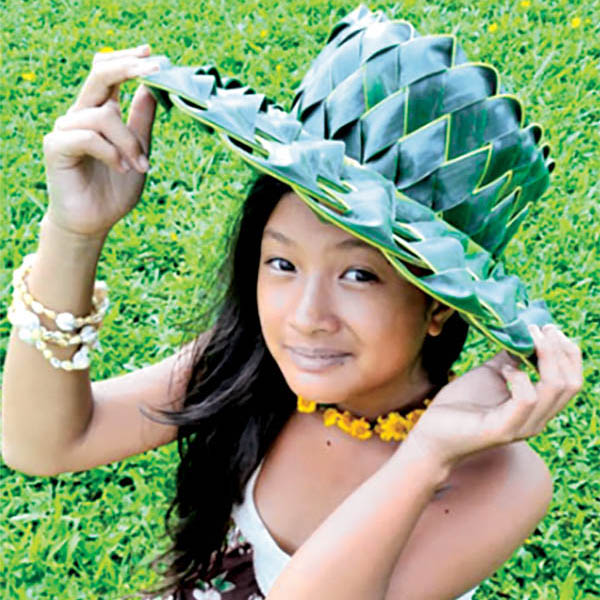
Sharing the Art of Palm Craft with Sylph Nightbloom
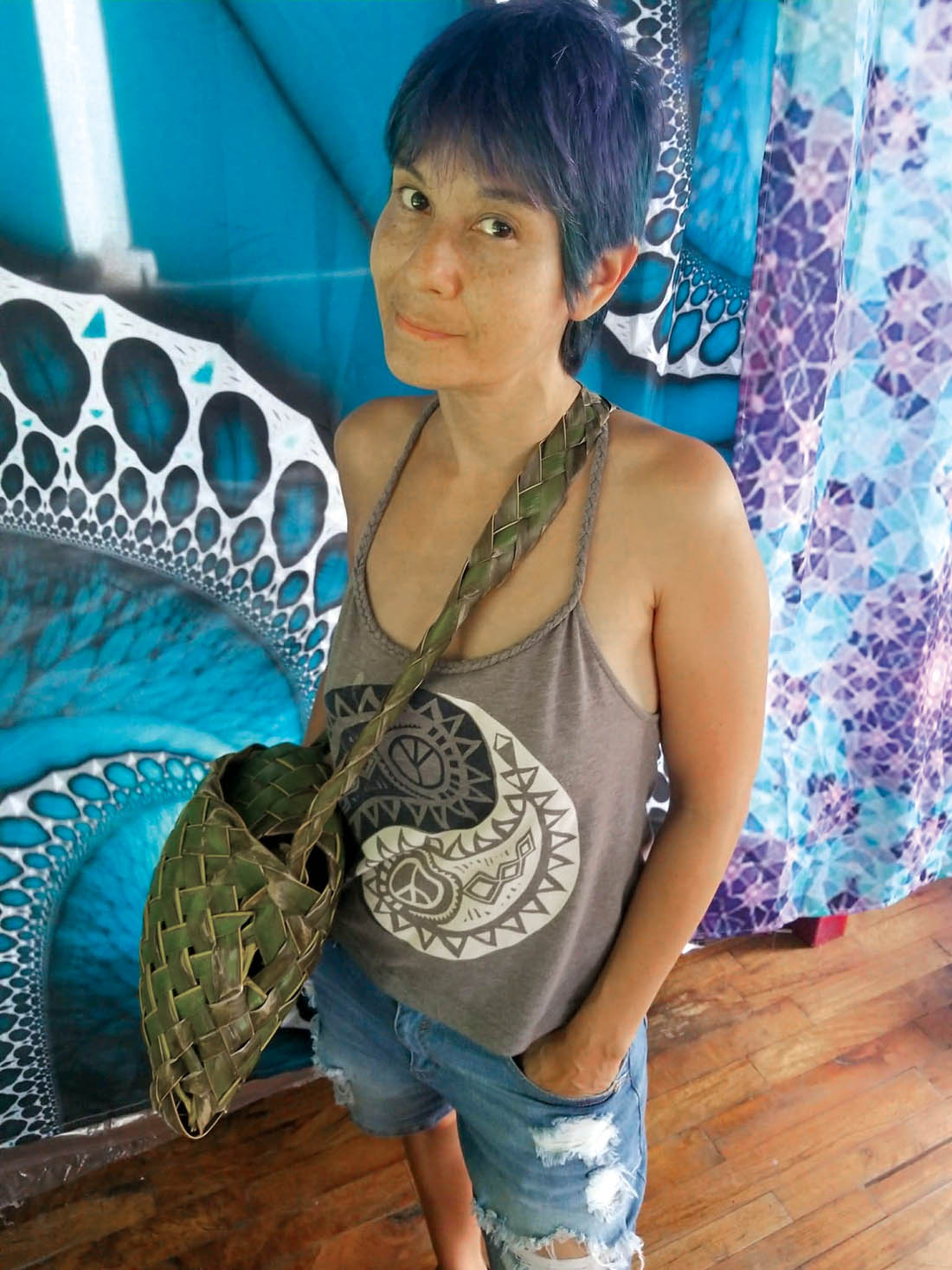
By Mālielani Larish
With a luxurious green palm frond perched on her lap, Sylph Nightbloom gives the opening instructions to the workshop participants gathered around her.
“Lift the first two palm leaflets up,” she says as she demonstrates, “so they look like a bug’s antennae.” Matching her movements and following her guidance, the attendees soon fall into a comfortable working rhythm, busily weaving and chatting as they delightedly observe their baskets taking shape. On this misty afternoon in Orchidland Estates on Hawai‘i Island, the guests—all of whom are brand new to coconut palm weaving—are here to make a three-tiered basket chain. A light-hearted atmosphere fills the room as the students relax into the process.
In addition to offering workshops around the island, Sylph creates custom palm craft made to suit her client’s specifications. A self-taught weaver, palm weaving has empowered Sylph and enriched her life in many ways. She loves passing on that sense of empowerment to her students, who learn a life skill that is sustainable for the planet and inherently satisfying.
Workshops for Every Level
Sylph offers seven levels of workshops—from beginner to advanced—and every student receives a link to a private follow-up instructional video so that they can review every step of the process. Sylph began to teach palm weaving in 2013, and held her first workshops on Hawai‘i Island in 2017. Her students benefit from her attentiveness, precise guidance, and wise advice.
“She has taken the time to break down the skill in order to teach it,” says Eric Wolf, who has attended Sylph’s weaving workshops. Eric himself is a long-time teacher of earth skills who works as a licensed clinical social worker at Root 2 Rise Counseling in Hilo. Eric and Sylph both value the therapeutic benefits of weaving. The cool, leathery feel of the leaflets, the fresh scent of the fronds, and the coordinated hand movements help the weaver cultivate a mindful awareness that can foster a sense of calm and ease.
Because every frond’s leaflets bring different lengths, widths, and spacings to the table, Sylph says that a successful weaving experience is “like a dialogue between the weaver and the frond.” Instead of trying to force expectations onto the frond, the weaver works synergistically with it, coaxing its inherent strength, flexibility, and beauty to the forefront in a new form. That synergistic relationship between the weaver and the frond is part of what makes weaving so magical.
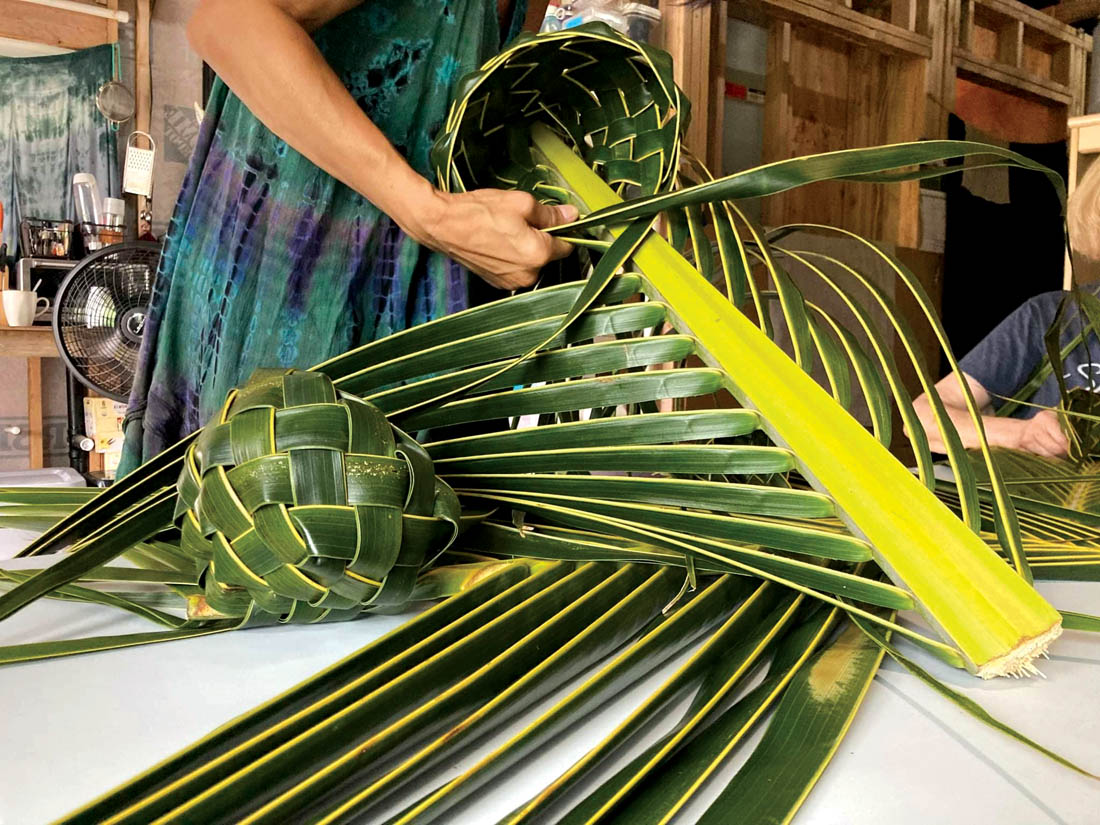
The Tree of a Thousand Uses
As the students’ hands engage in quiet dialogue with the fronds before them, Sylph’s partner, Ahrubi Arcturi, offers the workshop participants freshly-opened coconuts for sipping. It is no wonder that the coconut is revered throughout the coastal tropics; every part of the tree boasts a multiplicity of uses. Researchers believe that the modern-day coconut palm originated somewhere in Malaysia, where the tree is indeed known as “the tree of a thousand uses.” Palm weaving has been practiced throughout the tropics for millennia, and each region possesses its own traditional techniques and forms.
In ancient Hawai‘i, coconut palm fronds were plaited into fans, balls, and loose mats for thatching canoe sheds. The fibers of the coconut husk were pounded, cleaned, and plaited to form a strong cord favored for lashing canoe parts. Interestingly, coconut palm cultivation was not as widespread in Hawai‘i as it was elsewhere in the Pacific, partly because Hawai‘i is located a little too far north to provide optimal growing conditions for the tree. Around Hawai‘i Island, coconut groves descended from ancient plantings are found at Honu‘apo, Hōnaunau, Kailua, Hawi, Waimanu, Waipi‘o, Hilo, and Puna.
Cherished Palm Craft

Sylph loves that her students often send her photos demonstrating how their finished weaving projects have become cherished and functional parts of their homes and lives. She gets just as excited about her projects as her students, especially because she has a flair for experimentation and innovation.
Sylph has invented her own palm baseball cap, functioning pinwheel, yoga mat tote, flap-closure backpacks, and shoulder bags—and she is always experimenting with adding new twists to well-loved designs. Her house contains a delightful collection of the 50 (and continually expanding) palm projects that she makes. The overhead light illuminating her living room filters through a palm lamp shade embellished with koi-like braids. Using a triaxial weaving technique, Sylph crafted the finely-woven palm medicine pouch that she wears. An exquisite little honu (green sea turtle) made from micro-woven palm leaflet strips rests on the table.
Palm creations are practical, durable, and gentle on the earth. Sylph hauls her laundry in a large cylindrical basket made of palm, and when she needs to outfit herself for an adventure, she can fit her gear into a spacious palm backpack and choose from five different palm hat styles. One of her sturdy palm carrying bags, which is reinforced with a two-ply bottom, accommodates five full water bottles.
Bringing a broad-brimmed, closed-top hat to the table, Sylph explains that it was the first design that she learned to weave. “Basically, this craft saved my life,” she says.
A Passport to Freedom
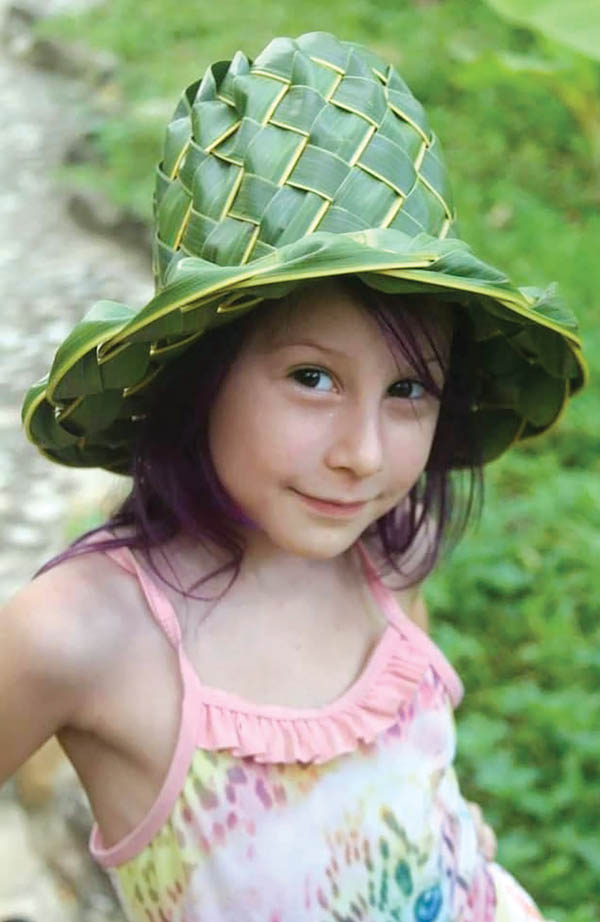
In 2013, Sylph and her family were living in Belize in an off-grid community with no internet connection, and Sylph was desperate to make enough money to leave the not-so-ideal living situation.
While strolling along a sandy beach on her day off, Sylph noticed a local man wearing a vibrantly green palm hat. She immediately sprinted after him, and gasping for breath upon catching up with him, asked if he could show her how to make the hat.
“I didn’t make this hat,” he replied, adding that the weaver of the hat had recently left the country. A little crestfallen, but still determined, Sylph asked if she could borrow the hat for a brief period. In exchange for a dollar, Sylph had one hour to inspect the hat. Armed with a mental blueprint, Sylph invested all her free time in the following two weeks into trying to duplicate the hat. After 20 attempts, each of which required harvesting a large frond and whittling down the great rib to make it flexible, Sylph finally succeeded in duplicating the hat.
“When you learn something like that by trial and error, you don’t ever forget how to do it,” she says.
Next, Sylph attempted to make a tiered basket chain after noticing one hanging in the kitchen of a local family. After receiving permission to study it, she successfully produced the first tier of the chain within 15 minutes of laying her hands on a frond.
Sylph wondered if she could make enough money to support herself and her family by selling the two palm craft items that she had taught herself to weave. After leaving Belize in favor of neighboring Mexico, she got a chance to find out.
Sharing a Sense of Empowerment
With the help of a good Internet connection in her new home in Mexico, Sylph admits that she went “hog wild” looking up new palm craft projects. She also borrowed the classic University of Hawai‘i publication entitled What Are Fronds For? from a Mexican library and mastered every project contained therein. Her business in Mexico blossomed, and she began to offer weekly palm weaving workshops in addition to selling her crafts at local markets.
“This whole journey has been about empowerment for me. I started out thinking I needed a teacher to show me how to do something obscure and challenging, and discovered that I could find helpful resources, or figure it out by myself,” says Sylph.
She was able to pass on that sense of empowerment to her very first weaving student, who was a teenage boy in Mexico. She knew that the boy’s father would balk to see his son weaving. When Sylph sat down with him and guided him through his first palm project, it was evident that weaving came naturally to him.
“It was great to see him grow confidence in his actual self, instead of trying to be something that somebody else expected him to be,” she says. “I love to see my students, many of whom have never made any crafts with their own hands, discover that they can weave something beautiful and useful.”
Eventually, Sylph decided to return to the US on one condition: that she could continue palm weaving. She had dreamed of living in Hawai‘i since the age of four, so moving to the islands was a natural choice.

Circling Back to Gratitude
Back at the workshop, Sylph adds the finishing touches to her tiered basket chain by carefully “inch-worming” the length of each woven leaflet along its path, thereby achieving a tighter weave.
Embracing the topmost basket between her hands, she inhales the pleasing scent of the verdant frond, saying, “This material and this art inspire so much gratitude in me.”
The students admire each other’s basket chains, marveling at how unique every person’s finished project is. There is a palpable sense of accomplishment in the room, and one of the students asks: “When is your next workshop?” ❖
For more information:
facebook.com/sylphnightbloom, spiralsylph.com
References:
What are Fronds For? Arbeit, Wendy. University of Hawaii Press, 1985.
Native Planters in Old Hawaii: Their Life, Lore, and Environment. Handy, E.S. Craighill and Handy, Elizabeth Green. Bishop Museum Press, 1991. pp. 173–174.

